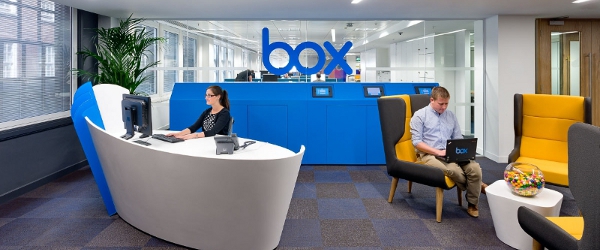
Business without boundaries is not an unfamiliar concept, but a computing environment entirely free of boundaries is still far from reality.
Cloud company Box hosted the Business without Boundaries conference to discuss the future cloud computing, mobile working of IT in enterprise. Respected business author Geoffrey Moore was in attendance to express his personal views on the matter. After having published the successful book, Crossing the Chasm, he now has opinions on how enterprises can cross over into the next generation of IT.
At a roundtable with the infamously charismatic Box CEO Aaron Levie, Moore, and CIO of Gatwick Airport Michael Ibbotson (Gatwick utilises Box in its IT infrastructure) the direction of enterprise IT was discussed at length. Discussion ranged from the move from on-premise to cloud, the move from desktop computing to tablets and systems moving to become more social-centric and the shared use of information.
Box’s success as a SaaS provider is evident through its recent expansion of staff: 80 employees in Europe, double since six months ago, which is commensurate with demand from customers. From Box’s new headquarters in London, it has embarked on recent partnerships with Hounslow Council, EE and Gatwick Airport.
CEO Levie says: "We’ve been pleasantly surprise and it has exceeded expectations in terms of the amount of interest in the cloud and the exact same trends that are transforming businesses in the US are happening here as well.
"It’s about how to implement new tech in business from new set of vendors to tackle new set of problems to create a new kind of experience: that’s what we’re really excited to be a part of."
The security paradigm
When it comes to cloud computing, the first question that usually spring to mind is one of security. Levie appreciates that this changes when moving information off-premise: "What we found is the security paradigm for the most part was, if I can lock down information, keep it on premise, then I can keep it secure. But the challenge is people still go around that people because they have to share information. So it’s great in theory, but in practice when you need to collaborate with anybody outside that firewall, you have to go to IT [department] and that takes weeks, or may not work out.
"What we try to advocate is: if you can introduce things that are a little more self-service, a little bit more open, it will give people the trust and ability to control information themselves. By doing that they’ll put all their information in that sanction platform where you’ll get visibility and get the analytics and all of the awareness of what is happening to your data.
Gatwick Airport CIO Ibbitson highlighted that trust people to control information themselves can open up another can of worms as enterprises lose corporate control of their information when it leaves the parameters of the company server.
He says: "I think the people within our organisation are just as big a threat as the technology. That’s something we’re always forgetting. We’re working hard at Gatwick to re-educate the employees about information security: what they can share and what they can’t share. We provide these tools now so they can share with anything with anyone one pretty quickly – but what should you be sharing?
"BYOD is about the education because if they can copy that file onto a USB stick and Dropbox and fileshare4u.com [it’s not safe]. But if you give them Box and integrate it so it replicates everywhere, they are more likely to use that. Then you’ve got corporate control over it. So if you embrace it and use the tools, they’re much more likely to buy into it and then educate them on how to use it."
Collaborative working with BYOD
Moore and Levie debated the changing structure of work in IT. Moore explained how a whole bunch of forces were enabled in the consumer world and then the enterprise saw productive resource so BYOD movement, leading to a cross-over between the two.
Levie says: "How does IT move to more user-centric IT that is fundamentally about enabling users and systems of engagement? And how do you help your employees to get the most out of their technology and their information?"
"The unseen phenomenon [in BYOD] is the notion of how productivity is shifted," responds Moore.
"I was raised in an era of individual productivity and personal computing made individuals phenomenonally more productive. One of the keys to that was not to collaborate because the idea behind that was you got things done and perhaps had a share point you would expose them to collaborative forces, but the suspicion was they would either dumb you down or slow you down."
Moore continues: "Another generation has come along and said, ‘that’s not how we do it.’ Collaboration when I went to school was called cheating, and you were expelled for it. So obviously, my generation could design a collaborative infrastructure that is particularly interesting. But this generation has.
"So what used to be a passive media response has now become engagement as an agent. So when you look at the enterprise use of Box, it’s designed to be an active agent in the world and to get things done with a collaborative motion," he says.
Moore said he thinks you’ll see an adoption lifecycle that will follow to some degree generational exposure, but with the pressure of exposure in a disaggregated world economy. You must negotiate across that value chain more quickly and efficiently.
Cloud is secure; air is not
Levie continues to range the point of expanding communications beyond the four walls of your office. Particularly as software like Sharepoint were designed as on premise. "It was fundamentally designed for a world that would exist within your LAN inside of your building and we happened to come in at a time where you are sharing with your colleagues and collaborators and people outside of your business, so you need new software to help you do that," he explains.
"A software company can’t be designed at this point that doesn’t fundamentally imagine a world where most information you are working with is exposed to people who work outside the boundaries of that business.
"It’s not just the people in the four walls of your building, but it’s the extended network that you need to work. For the most part, the past half a trillion of investment over the past decade or so doesn’t imagine that kind of world, so we need a re-architecture of the enterprise to make that possible."
Moore contributed that one of the ironies of this situation is that the most insecure thing is the air, not the cloud. "All of this data is eventually going to go wireless to a device, you cannot put a firewall around air. Therefore this whole conversation is somewhat mute."
Shift, or swap out
Levie advocates the need for technology companies to move with the time, or risk being swapped out for competitors who are one step ahead. Ibbitson exemplified this at Gatwick when all staff BlackBerry handsets were replaced by Android devices in the BYOD scheme. Levie says: "It’s a very pernicious thing that can happen in this kind of business. So a software business that doesn’t think they are in the consumer tech business doesn’t really understand where the future is going.
"This shifts the onus to the vendor. If we don’t stay competitive as a vendor and build that next thing the customer wants to do and build it in a simple way with the consumer tools they’re using: you will get swapped out.
"That’s the remarkable competitive force that’s going to drive software in the enterprise; it will finally have the same kind of forces in consumer tech."







